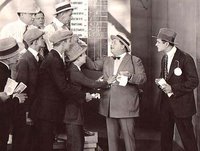 in teaching about sexual norms and practices, i’m struck by how little information we have about some of the basic social facts. a new study by gary gates at ucla’s sexual orientation law institute brings some new data to bear on the subject. based on analysis of the census bureau’s 2005 american community survey, it appears that the number of self-identifying same-sex couples rose dramatically from 2000 to 2005.
in teaching about sexual norms and practices, i’m struck by how little information we have about some of the basic social facts. a new study by gary gates at ucla’s sexual orientation law institute brings some new data to bear on the subject. based on analysis of the census bureau’s 2005 american community survey, it appears that the number of self-identifying same-sex couples rose dramatically from 2000 to 2005.
the study reports that the number of same-sex couples in the U.S. grew by more than 30 percent from 2000 to 2005, from about 600,000 couples in 2000 to almost 777,000 in 2005. this likely signals a major shift in willingness to report the nature of the relationship rather than a major shift in actual relationships. given the magnitude of the change, i’ll need a bit more assurance that the imperfect indicators are at least consistently measured at the two data points. if measurement artifacts aren’t a huge problem, the shift likely indicates that the stigma associated with same-sex partnering is rapidly diminishing.
the report offers some intriguing estimates on the spatial distribution of sexual preference. minnesota is among the top ten states in the estimated percentage of gay men, lesbians, and bisexuals in the adult population at 4.7 percent. i figured that urban d.c. would be have a high percentage of same sex couples, but i’m not sure why new hampshire and washington are ranked so high. is willingness to report higher in these states? (and, does affluence or racial homogeneity have something to do with willingness to report?). or, are there simply lots of same-sex couples in washington and new hampshire?
Rank and Estimated % of gay men, lesbians, and bisexuals in the adult population
1 District of Columbia 8.1%
2 New Hampshire 6.6%
3 Washington 5.7%
4 Massachusetts 5.7%
5 Maine 5.2%
6 California 5.2%
7 Colorado 5.1%
8 Vermont 5.1%
9 New Mexico 4.9%
10 Minnesota 4.7%
both new hampshire and minnesota had high rates of growth in same-sex couples, though these numbers are a little misleading because the 2000 base rates were rather low in most midwestern states:
Rank and % Increase in Same-sex couples, 2000 to 2005
1 New Hampshire 106%
2 Wisconsin 81%
3 Minnesota 76%
4 Nebraska 71%
5 Kansas 68%
6 Ohio 62%
7 Colorado 58%
8 Iowa 58%
9 Missouri 56%
10 Indiana 54%
finally, the twin cities ranks high among metro areas (5.7%). at 12.5%, minneapolis ranks behind only san francisco (15.4%) and seattle (12.9%) in the estimated percentage of gay men, lesbians, and bisexuals.
estimated % of gay men, lesbians, and bisexuals in metro and largest city
1 San Francisco-Oakland-Fremont 8.2% 15.4%
2 Seattle-Tacoma-Bellevue 6.5% 12.9%
3 Boston-Cambridge-Quincy 6.2% 12.3%
4 Portland-Vancouver-Beaverton 6.1% 8.8%
5 Tampa-St. Petersburg-Clearwater 5.9% 6.1%
6 Austin-Round Rock 5.9% 4.8%
7 Denver-Aurora 5.8% 8.2%
8 Minneapolis-St. Paul-Bloomington 5.7% 12.5%
9 Orlando-Kissimmee 5.7% 7.7%
10 Hartford-West Hartford-East Hartford 5.6% 6.8%
looking at these descriptive statistics, i can’t help but note the high ranking of some of the nation’s most attractive places: san francisco, seattle, minneapolis, boston, and portland are the top five cities on the list. it ain’t exactly sodom and gomorrah, right?
do the fervent critics of same-sex marriage actually sound the alarm that their burg could “become just like new hampshire?” or warn, “look what happened to portland!” based on these data, i know where i’d be happiest living and raising my kids: in places where there are many same-sex couples and, just as importantly, where there is little or no stigma attached to sexual preference.
 nancy herther, the minnversity’s fine sociology librarian, prepared this handy report comparing searches of sociological abstracts with those of criminal Justice abstracts.
nancy herther, the minnversity’s fine sociology librarian, prepared this handy report comparing searches of sociological abstracts with those of criminal Justice abstracts. 




